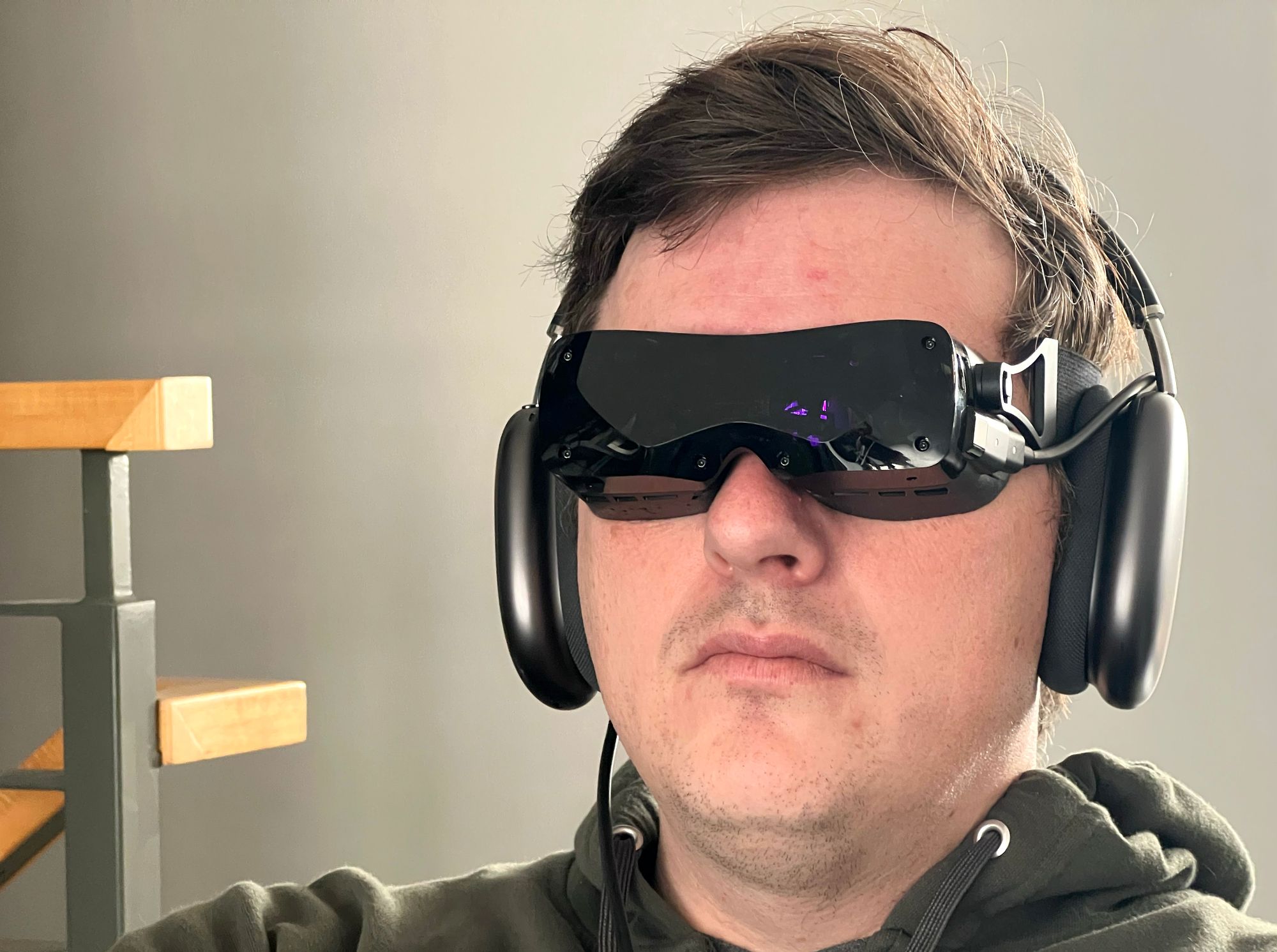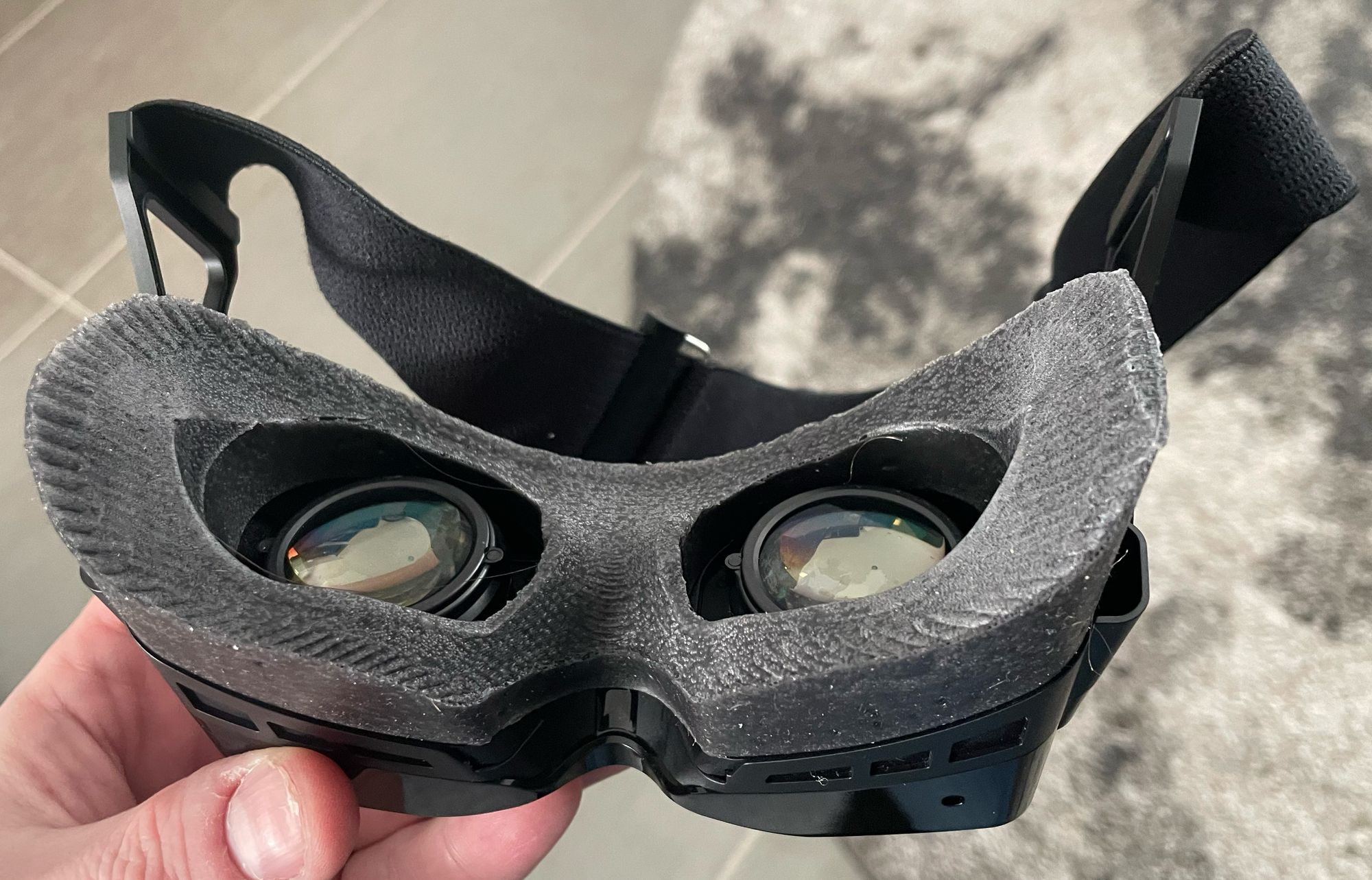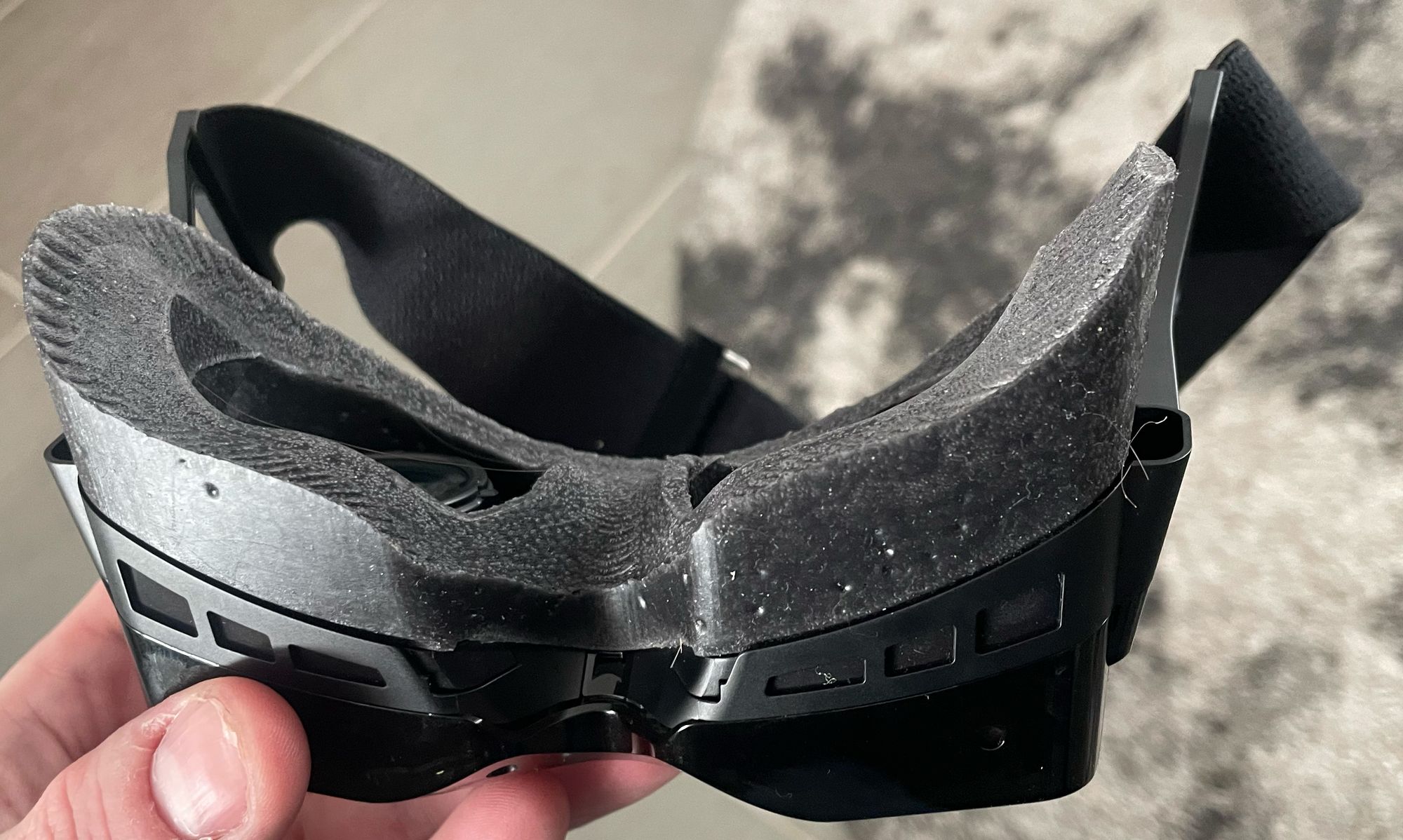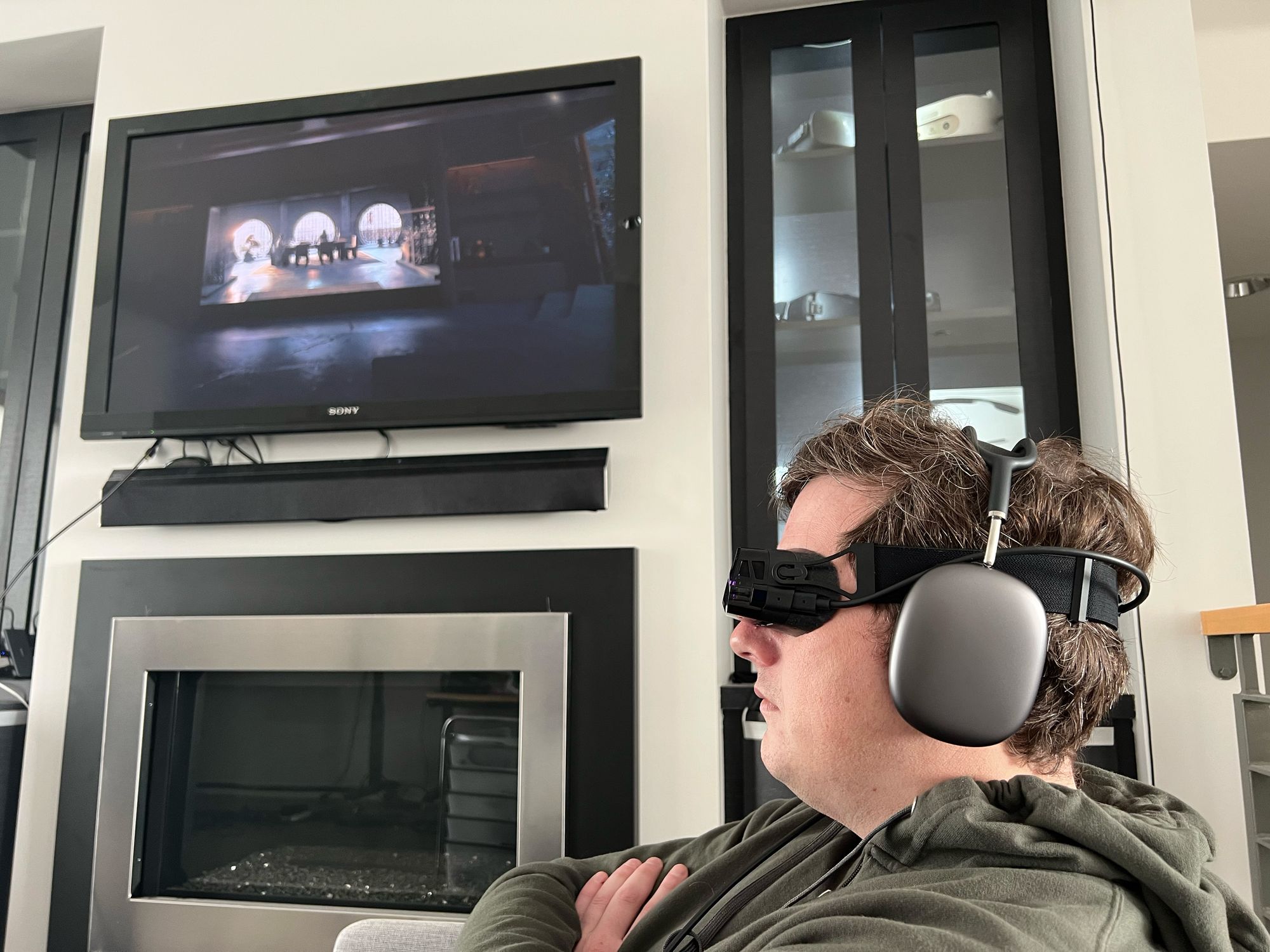I recently tried out a "pre-production model" of the Beyond PC VR headset and spoke to Bigscreen Founder & CEO Darshan Shankar for about two hours.
I watched the entirety of the 2021 film Dune in Bigscreen Beyond while talking with Shankar. He piped audio for the movie into AirPods Max. I raised the headset from my eyes only to start and stop an audio recording on my phone, enjoyed coffee and cold water while watching, and spent most of my time just enjoying the movie while thinking about the pros and cons of his $1,000 headset’s unique design.

Beyond is a custom-fitted device. I sent Bigscreen my face scan from iOS and interpupillary distance as measured at an eye doctor’s office. It's very possible, however, that my particular face shape could be unusually challenging to fit. If the distance from the center of your face to the middle of your pupils is symmetrical (mine isn’t), there’s a chance your experience with Bigscreen Beyond may be quite different from mine.
So with that in mind, and knowing that we intend to review a finished consumer version of this device in the coming months, I’m going to focus on how Beyond moves the conversation forward about VR in substantial ways, and then mention some of the downsides I noticed in my personal experience.
Bigscreen Beyond Shifts VR’s Comfort Conversation

Bigscreen Beyond’s weight is without compare in a PC VR headset design with SteamVR Tracking. It puts 127 grams of hardware on the front of the face plus around 30 grams in the face cushion and approximately 10 to 20 in the strap, according to Shankar. The headset might as well exist in a different VR product category because its weight reduction forces the rest of the market to take a long hard look at its headache-inducing reality.
Keep in mind headsets vary wildly in various ways that affect functionality and weight distribution, but here's some other headsets for comparison:
- Vive Flow (189 grams)
- Vive XR Elite (270 grams without rear battery)
- Oculus Go (468 grams)
- Oculus Rift (470 grams)
- Meta Quest 2 (503 grams)
- HTC Vive (566 grams)
- Oculus Quest (571 grams)
- Meta Quest Pro (700 grams)
- Valve Index (807 grams)
Some businesses already serve niche markets with VR headsets maximizing certain specifications. Pimax focused on designs maximizing field of view and Varjo makes headsets that take resolution as far as it can go. Bigscreen focuses on weight, and while field of view or resolution might be instantly visible, Beyond’s key difference settles in across time.
"We focus on immersion and comfort," Shankar said. "Gen 1 VR needed to prove the medium and the form factor and get its legs. We proved unequivocally VR is here to stay, in 2016 we didn't know that. And now in 2023 we can ask what's next, and Bigscreen's big bet is that VR should be custom fit."

Weight is one of the main reasons you’ll take a headset off. I'd wager it is probably the main reason so many current headsets sit unattended. I don’t look at my headset sitting there and ponder the screen door effect before putting it on, I remember an overall feeling of discomfort gravity caused the last time I spent an hour with it on my face.
Bigscreen Beyond is the first time I took off the headset after spending hours in VR and simply felt nothing emanating from my temples. Instead of my whole head pulsing with a sudden sense of relief, my eyes refocused on their physical surroundings again in a way that felt more more like walking out of a movie theater and suddenly being awash in bright light.
It is one thing to suggest a headset like Valve Index or Quest Pro balances the weight of a brick on your head in a “comfortable” way. Now that Beyond exists that entire framing is shattered. Most earlier VR headsets were simply too heavy to be comfortable to wear for long periods and the trade-offs in those designs made the best of a bad situation. Bigscreen Beyond made different trade-offs to make fitting a part of the process of getting your headset. No IPD adjustment. No cameras. No included audio output. No battery. No brick on your head. Just SteamVR Tracking and your virtual environment.
I joked with Shankar while wearing the headset and drinking from a cup that the experience was like a cold glass of water on a hot day. I stand by the comment as a decent analogy for the overall sense of relief it delivers.
Visual Performance & Zero Light Leakage

I found myself moving my head around a lot to center the sweet spot of Bigscreen’s lenses on specific regions of the movie’s picture on the massive virtual home theater screen in front of me.
Beyond’s edge-to-edge clarity is a step backward from Meta’s new lenses used in Quest Pro. On resolution, Bigscreen claims Beyond's design achieves 28 pixels-per-degree while Quest Pro reaches 22 pixels-per-degree. I didn't try the headsets back to back, but I can say that when I centered my eyes to the middle of Beyond's lenses the picture quality in Bigscreen's virtual theater was seriously impressive.
My personal fit with Bigscreen Beyond though, which I suggested earlier as likely to differ from others, also left me distracted by internal reflections which caught my eye as well. There’s another aspect to Beyond's trade-offs that comes into play. Because the headset is so light, moving your head more often in Beyond is less physically taxing.
“Your head’s like, ‘okay, but I want that kind of sharpness. And you end up moving your head a little bit more," Shankar said. “There’s a subtle aspect of the headset being so light that you end up moving your head more than you would in something else because you have the inertia of a bigger headset."
Beyond’s custom fitted face pad blocked all light leaking in. Meta sells a “full light blocker” for the Quest Pro that’s $50, but I must stress that, like its weight, Bigscreen Beyond entirely redefines this terminology. Even Meta’s “full light blocker” still lets in light, whereas Bigscreen Beyond truly features zero light leakage. It is just such a striking difference to feel so little weight on your face while still feeling entirely transported to a virtual environment, and the difference in light leakage is part of that experience.
When I finally took the headset off after my full movie in VR — one of the first times I’ve done that in more than a decade of reporting on this technology — and afterward it took my eyes quite a bit of time to focus normally on my physical surroundings.
“This is in the December batch of units,” Shankar explained. “The focal distance was a little bit off. So your focal plane was a little bit off.”
Shankar says they’re still fine tuning some aspects of their manufacturing.
Proving A Point
My demo wasn’t on recent enough hardware, and my experience so affected by my individualized personal fit, that I won’t say anything interesting here about whether anyone reading this should or should not purchase a Bigscreen Beyond.
I will say that Beyond proves a point about the weight of VR headsets. Every gram on your face is poison when you’re trying to experience another reality. With hundreds and hundreds of grams weighing across your head, every moment in VR strains and drains. The first decade of consumer VR explored various aspects of making the medium more comfortable or compelling, from locomotion and frame rate to resolution and game development. At the start of consumer VR’s second decade, Bigscreen Beyond is making a bold statement about weight.
“The thing that keeps me up at night, the thing that’s like constantly scratching at me for the past decade is how to make VR useful enough that people would use it every single day,” Shankar said. “The number that I’ve always been saying is 10 hours a day. And the reason for 10 hours is because that overlaps between work and entertainment and it’s not just one or the other. VR has to get to that point…and I think VR is really, really close for some people out there. We are never talking about how to make VR go to a billion people. I think we’re just a good bit from that. It’s like talking about smartphones getting a billion users when we have like a phone inside of this briefcase in the ’90s. It’s gonna happen. But the path to get there? I’d rather talk about like right now…I think we are going to enable quite a few people to be able to spend 10 hours a day in VR. And with the next generation, that becomes a little bit more accessible, practical, doable.”






























